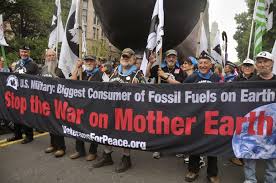You can’t have infinite growth on a finite planet. That should be a commonplace idea. And that inevitably means facing up to the necessity of putting an end to capitalism in favor of an economic system of rationality, sustainability and equity for all the world’s peoples.
It can’t be said too many times that the concept of “green capitalism” is a chimera. Unfortunately, belief in that chimera is not limited to the world’s center-left political parties; it extends to the world’s Green parties. Various “Green New Deal” programs have been floated in recent years, generally revolving around a massive buildout of renewable-energy infrastructure and strengthening the social safety net. On their own, there is no rational argument that such programs, should they materialize, would not provide some benefits. But how transformative are such programs?
Here is where “green capitalism” rapidly falls apart. Liberal assertions that a transition to a green economy will be virtually cost-free are unrealistic. The costs of a transition to a greener economy are much less than the costs will be of continuing business as usual — how much will a three-meter rise in the sea level and massive disruptions to agriculture cost? — but the need to transition millions of employees to new employment, retrofit or replace transportation systems, adjust to new trade patterns and have access to less energy shouldn’t be minimized. And the infrastructure to build solar panels, windmills and all else will use large amounts of resources, including toxic “rare earth” minerals. Renewable energy, although vital if we are to have a future, isn’t a shortcut to reversing global warming.

A fundamental problem is that capitalism is dependent on consumerism. Household consumption (all the things that people buy for personal use from toothbrushes to automobiles) constitutes 60 to 70 percent of a typical advanced capitalist economy’s gross domestic product; it is because of this dependency that so much money and effort is put into advertising and marketing, creating “needs” we didn’t know we had, and the pervasiveness of “planned obsolescence.” Consumerism and over-consumption are not “cultural” or the result of personal characteristics — they are a natural consequence of capitalism and built into the system. Problems like global warming and other aspects of the world environmental crisis can only be solved on a global level through democratic control of the economy, not by individual consumer choices or by national governments.
 Paypal/Card Other Options
Paypal/Card Other Options
Support Independent Media
Two statistics that provide perspective on the high cost of new and improved: About 40 percent of U.S. landfill waste is discarded packaging and the cost of packaging constitutes 10 percent to 40 percent of a product’s retail price. No rational system would propagate such waste, but capitalism is not rational; the endless pursuit of profit for a small number of people at the expense of everybody else and indifference to environmental cost are the natural consequences. “Green capitalism” is “doomed from the start” because maximizing profit and environmentalism are broadly in conflict; the occasional time when they might be in harmony are rare exceptions and temporary, wrote Richard Smith in his 2014 paper “Green capitalism: the god that failed.” This is because the managers of corporations are answerable to private owners and shareholders, not to society. Profit maximization trumps all else under capitalism and thereby sets the limits to ecological reform.
What has just been discussed is serious enough. But what if the impossibility of capitalism continuing for the foreseeable future is not only its inherent contradictions and destructive tendencies, as discussed above, but also due to physical limits? Endless growth, and a system that needs endless growth to survive, is not only impossible due to the finite nature of natural resources, the repression and exploitation that fuels it eventually reaching a point of explosion, and the inability to expand because the entire globe is now encompassed by it. It is also impossible in the long run because 100 percent recycling and conservation is a physical impossibility.
Laws of thermodynamics versus limitless expansion
An interesting paper just published in the Real-World Economics Review, “How entropy drives us towards degrowth,” lays this out in six succinct pages. Written by Crelis Rammelt, a professor of environmental geography and international development studies at the University of Amsterdam, the author concludes that global capitalism “annihilates its own habitat” and “devours the equivalent of an entire Mount Everest’s worth of resources every 20 months.”
You can’t have infinite growth on a finite planet. That should be a commonplace idea.
That’s a whole lot of resources! The number of months will be fewer in the future because, structurally, capitalism must expand. This is the dynamic of the system that is often obscured. The rigors of competition force all capitalists to reduce costs and find new customers to successfully compete; failure to do so means going out of business. With all competitors forced into this endless treadmill, the entire system is dependent on expansion and the creation of new markets. Now that capitalism has conquered virtually every space on Earth, there can be no more geographic expansion. Thus the pressure of competition only becomes more acute, as does the need to extract more natural resources, which will inevitably be more difficult and expensive to obtain as easily reached materials are exhausted.
Thus, Dr. Rammelt wrote, the search for short-term fixes intensifies. “This system demands continued accumulation of capital and falters when hindered in this process,” he wrote. “The typical response to the ecological crisis is therefore not to restrict economic growth but to pin all hope on efficiency, circularity, dematerialization, decarbonization, and other profit-driven green innovations within capitalism. In this exposition, I argue that this hope is false because entropy always looms. Entropy serves as a physical measure of disorder, and we observe its inexorable increase all around us: everything decays, rots, disintegrates, and falls into disorder.”

Energy changes form but does not disappear, he notes, but the second law of thermodynamics states that thermal energy (heat) flows from the hotter body or location to the cooler. In parallel with this law of entropy, energy flows from a place of high concentration (such as a battery) to a place of low concentration (such as a toy), thus resulting in a loss of energy for the battery. Entropy also shows itself in the degradation of everyday objects: food spoilage, metal erosion and clothing wear and tear. Something external has to provide supplemental energy to keep a system from complete degradation. For the Earth’s natural system, that external is the Sun. “The biosphere taps into solar power to perform ‘useful work,’ namely concentrating dispersed energy and matter into” new forms. “A healthy and well-functioning biosphere thus stands as the only force on Earth capable of counterbalancing the rise in entropy.”
Nature, however, cannot regenerate without limits. Although new food sources are created, sufficient for a natural biosphere and the life that inhabits it, “the metabolism of the destructive beast called capitalism expands too fast for the biosphere to keep up.” The metabolism of capitalism outstrips the ability of nature to regenerate itself. (Humanity is using nature 1.7 times faster than Earth’s biocapacity can regenerate). “Ecosystems have evolved over millions of years to optimize energy consumption in ecological food webs and to delay and reduce entropy through biodiversity,” Dr. Rammelt wrote. “Tragically, growth-oriented economies do the exact opposite by pushing against this natural order and increasing entropy at a devastating rate.”
It’s a physical world no matter what we wish
Substituting one-crop monocultures for more varied agriculture, irrigation, more intensive use of fertilizers and finally genetically engineering crops are among the ways that capitalism attempts to evade limits. But soil degradation, the creation of dust bowls, chopping down forests and pollution persist and become more dangerous. “Capitalism, in its pursuit of relentless growth, damages the very biosphere it relies on to mitigate its entropy-amplifying activities.” It is not a physical possibility to overcome environmental stresses by becoming more efficient or devising more ways to recycle more. Nature has its limits, Dr. Rammelt writes:
“Can we not combat entropy through frugal and circular production? The typical response to the ecological crisis isn’t to slow down growth but to rely on dematerialization and circularity. However, ‘green capitalism’ cannot maintain itself, let alone grow, by merely reusing its own waste and byproducts. Just as monkeys require fresh bananas from the forest and can’t survive on their own feces, production systems require new input of low-entropy matter and energy to function. The same goes for a forest that depends on solar energy from space and can’t survive solely on falling leaves. Shifting to biomass as a raw material for production also won’t save green growth as it will intensify pressure on land, water, and soil.”
At first glance, the fact that the global economy recovers less than 10 percent of waste materials and retains only 28 percent of global primary energy consumption after conversion would seem to indicate a vast potential for improvements in the efficiency of resource usage. But a closed system that loses nothing is simply impossible, because not everything is recyclable and because transmission losses are inevitable:
“[E]ven though we are far from achieving 100% circularity and efficiency, the laws of nature will always obstruct us from attaining such a goal. To counteract all unavoidable losses and inefficiencies, we require a constant influx of fresh, low-entropy matter and energy. This requirement holds true for circular economies and other green growth models as well. The encouraging news is that the biosphere can convert certain types and quantities of waste back into raw materials. However, we should not anticipate the biosphere to sustain this service at the same accelerating pace at which our economies increase entropy.”

That humanity can dominate nature “is an illusion.” The laws of thermodynamics remain in place. “Consequently, a growth-centered capitalist economy finds itself trapped in futile attempts to completely decouple itself from nature — aiming for a 100% circular, service-oriented and zero-waste existence. This obsession stems from an incapacity to imagine an economy that does not grow, where both the quantity and quality of its metabolism remain within secure ecological and planetary boundaries.”
Therefore, the conclusion is inescapable that an economy that requires continual growth must reach a physical limit; reaching such a limit is nothing less than global environmental collapse. Dr. Rammelt advocates a “radically different pathway”: degrowth. He defines degrowth as “a socio-economic transformation aimed at reducing and redistributing material and energy flows, with the goal of respecting planetary boundaries and promoting social justice.” Although he does not give a name to a post-capitalist system other than one of “degrowth,” such a sustainable system would have to be one that not only stays within the planet’s physical limits but provides enough for everybody. The material basis for everybody to have enough to eat and a place to live comfortably already exists; such a distribution is impossible under capitalism, where, again, production is performed for a small number of people to accumulate massive amounts of money with little left for everybody else.
Once again, Rosa Luxemburg’s thesis that either socialism or barbarism is our future stares us in the face.
ZNetwork is funded solely through the generosity of its readers. DONATE




